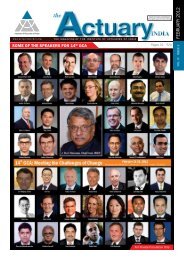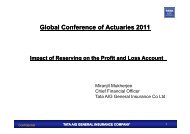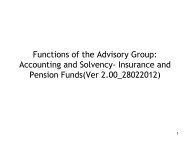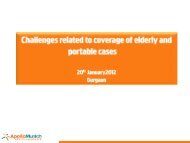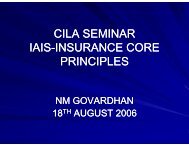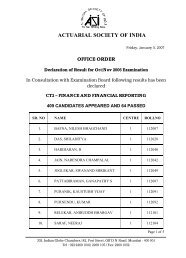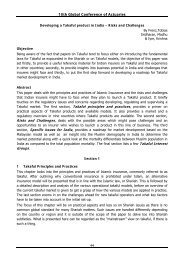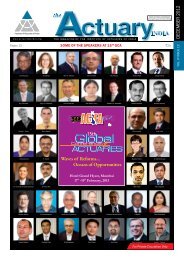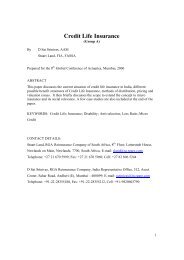January - Actuarial Society of India
January - Actuarial Society of India
January - Actuarial Society of India
You also want an ePaper? Increase the reach of your titles
YUMPU automatically turns print PDFs into web optimized ePapers that Google loves.
FEATURES<br />
x = (1 - x)<br />
y = (1 - y)<br />
End If<br />
If ((x) ^ 2 + (y) ^ 2) < 1 Then<br />
sumCircle = sumCircle + 1<br />
End If<br />
Next i<br />
pivalsample = (sumCircle / num) * 2<br />
+ 2<br />
End Function<br />
Using this technique it can be observed<br />
that our values so obtained are much<br />
closer to the actual value <strong>of</strong> pi, with the<br />
variance between 2 or more runs being<br />
lower than what we would have observed<br />
under naïve sampling.<br />
A comparison <strong>of</strong> ten values generated<br />
(with 10,000 random numbers for each<br />
run is given below along with the mean<br />
and variance <strong>of</strong> the sample.<br />
S.<br />
No.<br />
Pi<br />
value – naïve<br />
Pi value -<br />
sampled<br />
stratifying<br />
region sampling<br />
region<br />
1 3.115 3.1322<br />
2 3.142 3.143<br />
3 3.150 3.13<br />
4 3.122 3.13<br />
5 3.14 3.114<br />
3.15 3.133<br />
3.12 3.141<br />
3.132 3.1412<br />
3.135 3.1454<br />
10 3.143 3.15<br />
Average 3.1414 3.1432<br />
Variance 0.000251 0.000023<br />
You will observe that the variance is<br />
much smaller in the sampled simulation,<br />
with the mean value also being closer to<br />
actual value <strong>of</strong> pi.<br />
B) Importance Sampling :<br />
Earlier the method <strong>of</strong> stochastic<br />
integration was covered, which was<br />
based on generating points from<br />
distribution which we understand to be<br />
denser in areas where we the function<br />
is more concentrated. The key feature<br />
<strong>of</strong> importance sampling is to generate<br />
random numbers from those regions that<br />
we believe contribute to the most to the<br />
solution while avoiding low contribution<br />
regions. This type <strong>of</strong> sampling is called<br />
“Importance Sampling.<br />
As before, the difference between simple<br />
sampling and importance sampling<br />
for estimating an integral can be<br />
demonstrated as such:<br />
In the later case, each point is chosen<br />
in accordance with the anticipated<br />
importance <strong>of</strong> the value to the function<br />
and the contribution it makes weighted<br />
by the inverse <strong>of</strong> the probability (p <strong>of</strong><br />
choice. Unlike the simple sampling<br />
scheme, the estimate is no longer a<br />
simple average <strong>of</strong> all points sampled but<br />
it is a weighted average.<br />
Application <strong>of</strong> Sampling to Valuing<br />
Financial Assets (Simulating a plain<br />
vanilla call option on a stock with<br />
European Strike:<br />
Intuitively speaking simulating paths <strong>of</strong><br />
an asset from an initial time t to T, is a<br />
case <strong>of</strong> discretizing the path into smaller<br />
intervals, each path taking a value that<br />
can be described by a density function,<br />
which remains the same across the<br />
paths.<br />
Let the value <strong>of</strong> a call option is given<br />
by E[h(S] where the expectation is<br />
calculated under the density f(S. We are<br />
able to identify another density g(x which<br />
is denser in the region <strong>of</strong> our interest,<br />
than our simulation process can be much<br />
more efcient. Our expectation under the<br />
new density will now be given by [h(S<br />
f(S/g(s]. This can be represented as<br />
follows:<br />
We will be using the stochastic process<br />
followed by dS t<br />
to simulate the terminal<br />
value <strong>of</strong> the stock and arrive at the<br />
terminal pay <strong>of</strong>f using both naïve<br />
sampling as well as importance sampling.<br />
Under the naïve method we simulate<br />
assume f(dS t<br />
N(mu dt, sigma (dt.5<br />
whereas under importance sampling we<br />
use another distribution g(dS t<br />
N(r dt,<br />
sigma (dt.5, to simulate values <strong>of</strong> the<br />
stock.<br />
Essential as is seen above, importance<br />
sampling is simply the trick <strong>of</strong> changing<br />
the measure, more commonly known<br />
as the (application <strong>of</strong> Radon-Nikodym<br />
derivative.<br />
Provided below is the framework <strong>of</strong><br />
simulating the option price using naïve<br />
sampling under the risk neutral measure.<br />
a. Generate the incremental stock<br />
price in a descretized period using<br />
the stock prices process equation:<br />
dS t<br />
<br />
b. Calculate the terminal pay<strong>of</strong>f <strong>of</strong><br />
the stock price using the above<br />
simulated value<br />
c. Record the value and repeat<br />
the simulation exercise for a<br />
predetermined number <strong>of</strong> times.<br />
eep summing the terminal values<br />
so obtained.<br />
d. Average out the sum so obtained<br />
and discount it at risk free rate for<br />
the present value.<br />
We will be making use <strong>of</strong> the<br />
following assumptions.<br />
Risk free rate p.a 5<br />
Annual Volatility (standard deviation 20<br />
Current stock price Rs 100<br />
Strike Rs 150<br />
Time to expire 35 days (1yr<br />
rift under real world scenario 30<br />
Algorithm to simulate option price using<br />
standard (naïve Sampling:<br />
Dim S As Double, sigma As Double,<br />
r As Double, dS As Double<br />
Dim t As Long, counter As Long,<br />
times As Long<br />
Dim K As Double, Pay<strong>of</strong>f As Double<br />
t = 365<br />
S = 100<br />
sigma = 0.2<br />
r = 0.05<br />
K = 150<br />
Pay<strong>of</strong>f = 0<br />
For times = 1 To 1000<br />
For counter = 1 To t<br />
dS = (r / 365) * S + (sigma / Sqr(365))<br />
* S * BoxMueller_x(Rnd(), Rnd())<br />
S = S + dS<br />
Next counter<br />
Pay<strong>of</strong>f = Pay<strong>of</strong>f + Application.<br />
WorksheetFunction.Max((S - K), 0)<br />
S = 100<br />
Next times<br />
optionpay<strong>of</strong>f = Pay<strong>of</strong>f * Exp(-1 * r) /<br />
times<br />
End Function<br />
Provided below is the framework <strong>of</strong><br />
simulating the option price using<br />
importance sampling technique. The<br />
idea is to generate paths from the real<br />
world scenario and scale them to values<br />
from the risk neutral path using the<br />
Radon-Nikodym (RN derivative.<br />
a. Generate the incremental stock<br />
price in a descretized period using<br />
the stock prices process equation:<br />
dS t<br />
.<br />
b. Scale the paths using the RN factor.<br />
c. Calculate the terminal pay<strong>of</strong>f <strong>of</strong><br />
the stock price using the above<br />
simulated value<br />
20 The Actuary <strong>India</strong>



